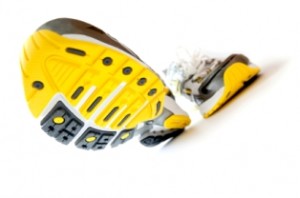Snookered by Sneakers?
Researchers Say Expensive Running Shoes Can Cause Damage to Joints, Knees

People running in high performance shoes put more torque on their knees than people running bare foot.
As something of a gym rat, I take my sneakers pretty seriously. They have to be comfortable, they have to look cool, but more than anything else, they have to relieve stress.
Let’s face it: When we exercise, we’re putting a lot of stress on our bones, joints and muscles. Of course, our muscles and joints become stronger after proper rest (one of the many reasons why rest is crucial to every exercise regimen) but the activity itself—depending on the intensity—is no walk in the park for our bodies (unless it is, in fact, a walk in the park).
Over the years, I’ve been fortunate enough to purchase far more good sneakers than bad ones. But the bad ones I’ve purchased have been REAL bad. One pair was so bad that my knees actually started to hurt whenever I ran or used an elliptical after a few months of wearing them. At the time, I thought it was a mild case of tendonitis. But I knew it was the shoes when I ditched those for a new pair.
With all the advances in sneaker technology, you’d think this wouldn’t be much of a problem, as sneakers surely are more packed with padding and support than they used to be. But a new study says that some of these sneakers are causing more pain than pleasure.
A study published in the December 2009 issue of the Journal of American Academy of Physical Medicine and Rehabilitation found that some of the premiere sneakers on the market today put more torque on the knees than running barefoot or walking with high heels!
The study used several different indicators to determine how much of an impact runners were putting on their joints. For example, electronic markers were placed on their knees so the researchers could actually see and measure what was happening as they were running (this, of course, required some highly sophisticated technology).
In addition to watching the participants run in a traditional setting, they also observed them running on what the researchers call a “glorified bathroom scale” in their bare feet. This also measured the amount of torque that was placed on the knees and joints.
Surprisingly, they found that people running with shoes—the very shoes that are supposed to minimize torque and resistance—actually brought on more torque than running bare foot. For example, in the part of the knee that often become arthritic in people with osteoarthritis, there was about 40 percent more torque among those running in sneakers than those running bare foot.
So, does this mean that you should kick off your sneaks and bare it all? Not necessarily.
“I think people should run in what they feel most comfortable running in,” said the study’s lead researcher to LiveScience. “Whether that’s in a pair of running shoes or in a minimum kind of running shoe, that’s fine.”
In other words, don’t get snookered into believing that if your shoe isn’t at least $150, you shouldn’t buy it. Pay attention to how the shoe feels on your foot and mimic as best you can the way in which you run right there in the store.
For this reason, it’s best to shop at a store that has space for you to run in place or ideally around the store itself. Stores that allow this usually employ specialists that can evaluate your gait and whether you over-pronate when you run.
Source:
msnbc.msn.com
Related Posts
- Run Down by Running?: To the Contrary, Running Improves Physicality with Age, Study Finds
- Flip-Flop Flub: Your Choice of Footwear and Foot, Joint Pain
- Rest May Not Be Best for Knee Pain
 
|
Enjoy this article? We guarantee your privacy. Your email address will NEVER be rented, traded or sold. |
Visit my new site: Self Help On The Web
 |
 |
Posted: January 31st, 2010 under joint pain, Running.
Tags: joint pain, knee pain, Running, running shoes, sneakers






